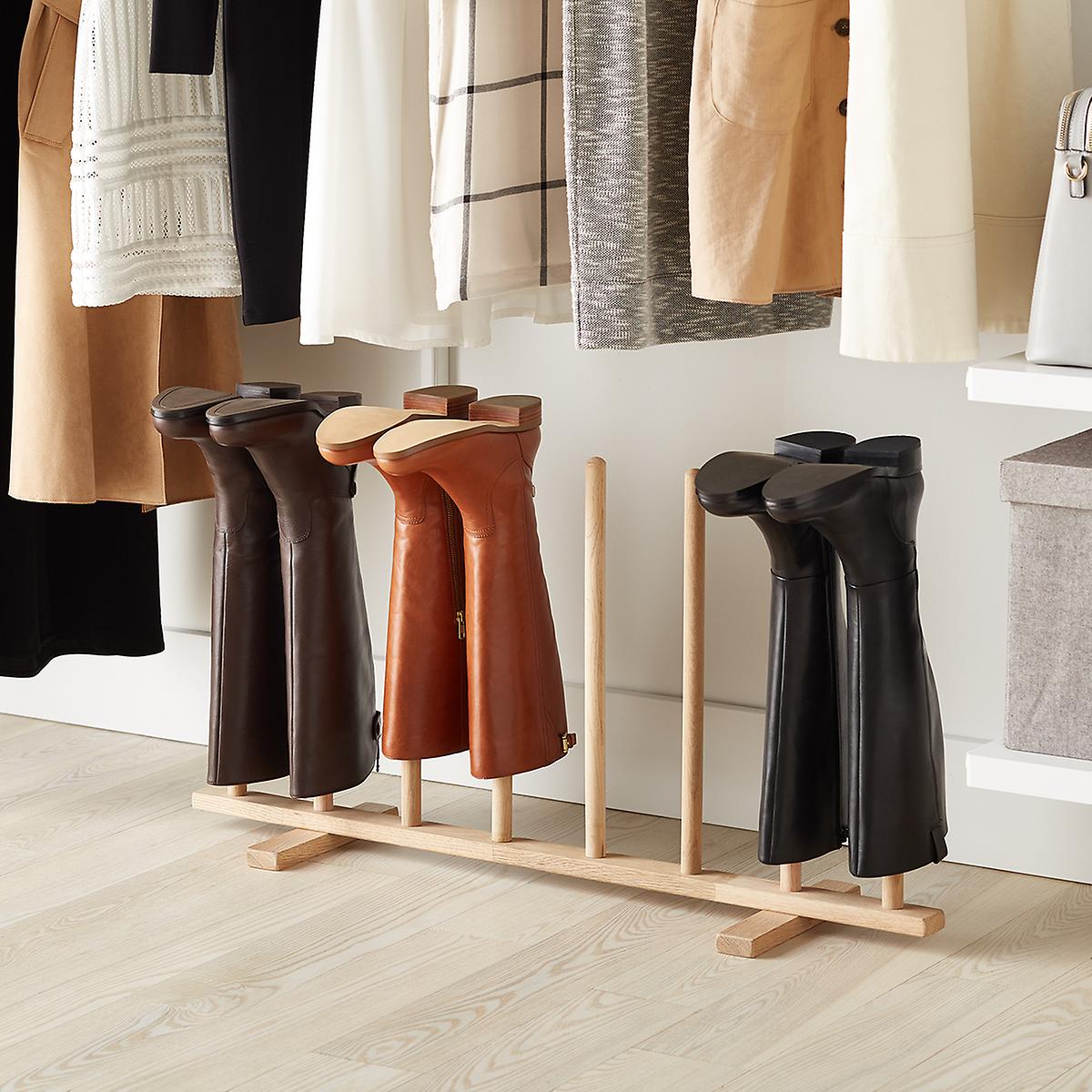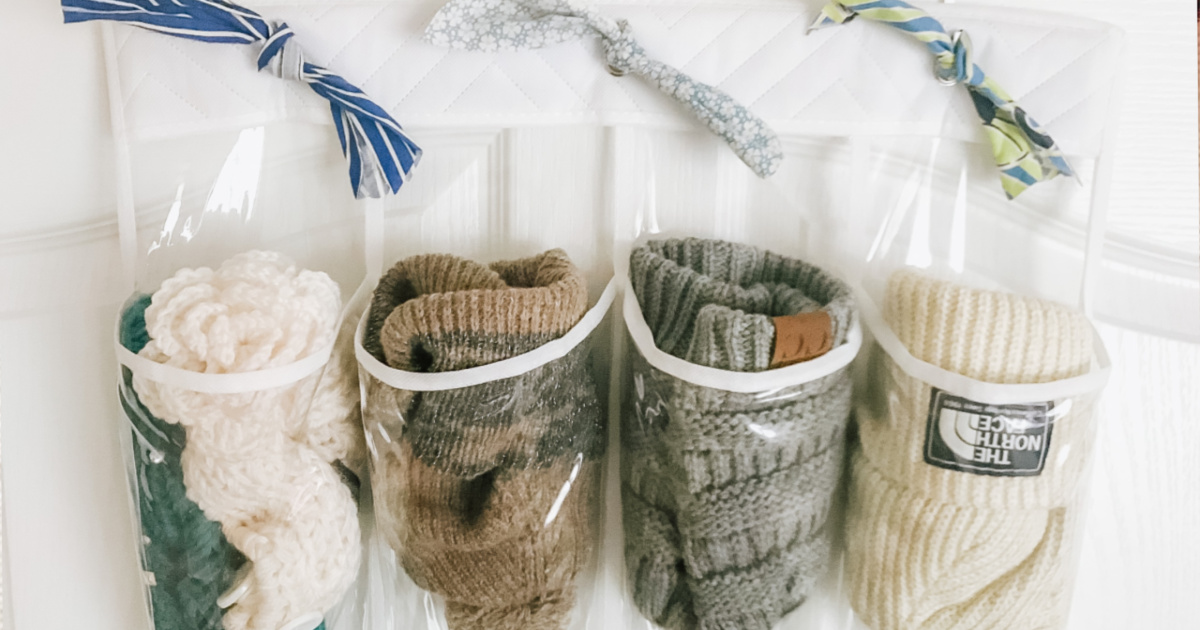

Articles
How To Store Winter Clothes In Summer
Modified: January 20, 2024
Discover effective ways to store your winter clothes during the summer months. Read our informative articles for tips and tricks on how to keep your wardrobe organized and preserved.
(Many of the links in this article redirect to a specific reviewed product. Your purchase of these products through affiliate links helps to generate commission for Storables.com, at no extra cost. Learn more)
Introduction
As the days get longer and temperatures start to rise, it’s time to bid farewell to those cozy winter clothes and make space for your summer wardrobe. However, storing your winter clothes properly is essential to ensure that they remain in good condition and are ready to be worn when the cold weather returns.
In this article, we will guide you through the process of storing your winter clothes in summer, from assessing and sorting to cleaning and packing. We’ll also provide tips on selecting the right storage containers, protecting your clothes from moths and pests, choosing an appropriate storage location, and monitoring and maintaining your stored items. By following these steps, you can ensure that your winter clothes stay fresh, organized, and protected during their time in storage.
Key Takeaways:
- Properly storing winter clothes involves assessing, cleaning, and organizing garments, choosing the right storage containers, and safeguarding against moths and pests. Following these steps ensures your winter wardrobe stays fresh and ready for the next cold season.
- Monitoring and maintaining stored winter clothes is crucial for long-term preservation. Regular inspections, proper ventilation, and using natural repellents help prevent damage and extend the lifespan of your favorite winter garments.
Read more: How To Store Winter Coats In Summer
Assessing Your Winter Clothes
Before you start packing away your winter clothes, it’s important to assess them to determine their condition and whether any repairs or alterations are needed. Take the time to go through each item and evaluate its wear and tear. This process will help you decide which clothes to keep, which to donate or sell, and which may need special attention before storage.
Start by inspecting your winter garments for any signs of damage, such as rips, tears, missing buttons, or loose threads. Set aside those items that require repairs and make note of the specific repairs needed. If you are handy with a needle and thread, you can mend these garments yourself. Alternatively, you can take them to a professional tailor for restoration.
Next, assess the overall condition of your winter clothes. Look for signs of excessive wear, such as faded colors, pilling, or stretched-out fabrics. If an item is significantly worn or damaged, consider whether it is worth keeping. Sometimes it’s better to part with old or heavily worn clothes rather than storing them for another season.
Additionally, evaluate whether your winter clothes still fit you well. Our bodies can change over time, and garments that were once the perfect fit may no longer be flattering or comfortable. If you have items that no longer flatter your shape or feel comfortable, consider donating them to someone who can make use of them.
By thoroughly assessing your winter clothes, you not only ensure that only the best and most wearable items are stored, but you also create the opportunity to refresh your wardrobe and make room for new pieces in the future.
Sorting and Decluttering
Once you have assessed your winter clothes and made necessary repairs, it’s time to sort and declutter your collection. Sorting through your garments helps you to organize them effectively and determine which items should be stored and which can be let go.
Begin by categorizing your winter clothes into different groups such as sweaters, coats, pants, and accessories. This categorization will make it easier to locate specific items when you need them again. Sort through each category and decide which pieces you want to keep, which can be donated, and which should be discarded due to the excessive wear or irreparable damage.
Consider whether you have duplicates or similar items that serve the same purpose. Be honest with yourself about how many winter coats or pairs of gloves you really need. Holding onto excess items only clutters your storage space and makes it difficult to find what you need later on.
When deciding what to keep, consider the versatility and functionality of each item. Think about how often you wore it during the last winter season and whether you plan to wear it again in the future. If an item has been sitting in your closet untouched for several seasons, it may be time to say goodbye.
For the items you plan to keep, organize them in a way that makes sense to you. This could be by color, style, or frequency of use. Utilize storage solutions such as dividers or labeled bins to keep everything in order and easily accessible.
By sorting and decluttering your winter clothes, you create a streamlined and organized storage system. This not only saves space but also makes it easier to find and retrieve your favorite winter pieces when the colder months roll around again.
Cleaning and Laundering
Before storing your winter clothes, it is crucial to clean and launder them properly. Even if your garments appear to be clean, they may still harbor dirt, stains, or odors that can attract pests and damage the fabric over time. Follow these steps to ensure your winter clothes are fresh and ready for storage.
Start by carefully reading the care labels on each item. Different fabrics and materials require specific cleaning methods, so it’s important to adhere to the manufacturer’s instructions. Some clothes can be machine washed, while others may need to be hand washed or taken to a professional cleaner.
For machine-washable items, separate them based on color and fabric type. Wash delicates on a gentle cycle with a mild detergent and cold water. Avoid using bleach or harsh chemicals that can damage the fabric. If the garment has stains, pre-treat them before washing using a stain remover or a mixture of water and laundry detergent.
For hand-washable items, fill a clean basin or sink with lukewarm water and a small amount of mild detergent. Gently agitate the clothes in the water, paying special attention to stained or soiled areas. Rinse thoroughly with clean water, then gently squeeze out excess water without wringing or twisting the fabric.
When it comes to drying your winter clothes, air drying is typically the best option. Lay sweaters and delicate items flat on a clean towel or mesh drying rack to retain their shape. Hang heavier items like coats and jackets on padded hangers to prevent them from stretching or developing creases. Avoid direct sunlight, as it can cause fading and discoloration.
Once your winter clothes are clean and completely dry, inspect them again for any lingering stains or odors. If necessary, repeat the cleaning process or take the item to a professional cleaner for further treatment.
Cleaning and laundering your winter clothes before storage helps to prevent stains from setting in and eliminates any odors that may attract pests. It also ensures that your clothes are fresh and ready to wear when you pull them out next winter.
Folding and Packing Techniques
Properly folding and packing your winter clothes is key to maximizing storage space and minimizing wrinkles and damage. Follow these folding and packing techniques to keep your garments in excellent condition during their time in storage.
Start by folding your heavier items, such as coats and jackets. Lay them flat on a clean surface and smooth out any wrinkles. Fold the sleeves towards the center of the garment and then fold it in half lengthwise. This method helps to prevent creases and maintains the shape of the coat or jacket.
For sweaters, fold them neatly and stack them on top of each other. You can also use acid-free tissue paper between each layer to prevent them from sticking together. Avoid hanging sweaters, as this can cause them to stretch or lose their shape.
Pants and jeans can be folded in half lengthwise and then folded in half again. Place them in the storage container with the folded edge facing up to prevent the waistband from getting wrinkled. If you have delicate fabrics like silk or satin, consider using tissue paper to protect them from creasing or getting damaged.
Smaller items like scarves, gloves, and hats can be rolled up to save space. Fold scarves lengthwise, roll them up tightly, and secure them with rubber bands or hair ties. Gloves and hats can be nested inside each other or placed in small pouches or bags to keep them organized.
As you pack your folded garments into storage containers, be mindful of the weight distribution. Place heavier items at the bottom and lighter items on top to prevent crushing or squishing. Fill any empty spaces with packing material like tissue paper or bubble wrap to help maintain the shape of your clothes and prevent shifting.
Label each storage container with its contents to make it easier to find specific items later on. You can also include a list of the items stored inside for quick reference.
By utilizing proper folding and packing techniques, you can optimize storage space, minimize wrinkles, and protect your winter clothes from damage. This ensures that your garments remain in excellent condition until the next cold season arrives.
Read more: How To Store Boots In Summer
Choosing the Right Storage Containers
When it comes to storing your winter clothes, choosing the right storage containers is crucial for keeping them clean, protected, and organized. Here are some factors to consider when selecting the appropriate storage containers for your garments.
Firstly, opt for containers that are made of durable materials like plastic or sturdy cardboard. This provides protection against moisture, dust, and pests. Avoid using containers made of fabric or materials that can easily tear or allow for air and moisture penetration.
Consider the size of your storage containers. Choose containers that are large enough to accommodate your folded clothes without cramming them in or causing excessive wrinkles. At the same time, avoid using containers that are too big, as this can result in unused space and unnecessary bulk.
Transparent containers are ideal for storing your winter clothes because they allow you to see the contents without having to open each container. This makes it easier to locate a specific item when you need it instead of rummaging through multiple containers.
If you prefer to use non-transparent containers, ensure they come with label slots or write-on surfaces. This allows you to label the contents of each container, making it convenient to find the specific items you are looking for.
Consider using containers with secure lids that provide a tight seal. This helps to keep out dust, moisture, and pests that could damage your clothes. Make sure the lids fit properly and are not easily dislodged.
Additionally, select containers that are stackable. This allows you to maximize vertical space in your storage area and keep your winter clothes neatly organized. Ensure that the containers are sturdy enough to support the weight of stacking without collapsing or damaging the contents.
Lastly, think about the accessibility of your containers. If you plan to retrieve your winter clothes frequently, consider using containers with easy-to-open lids or handles. This makes it convenient to access specific items without having to unstack or dismantle the entire storage system.
By choosing the right storage containers, you can protect your winter clothes from moisture, dust, pests, and damage. This ensures that your garments remain in pristine condition until they are ready to be worn again in the next cold season.
Store winter clothes in airtight containers or vacuum-sealed bags to prevent moisture, mold, and pests. Add cedar blocks or lavender sachets to deter moths. Keep in a cool, dry place.
Protecting Your Clothes from Moths and Pests
One of the biggest concerns when storing winter clothes is protecting them from moths and other pests that can wreak havoc on your garments. Moths are particularly notorious for feeding on natural fibers like wool, silk, and cashmere, causing irreparable damage. Follow these tips to safeguard your clothes from moth infestations and other unwanted pests.
Before packing your clothes, ensure that they are clean, as moths are attracted to stains and odors. Even small traces of food or body oils can attract moths, so thoroughly launder or dry-clean your garments before storage.
Consider using natural moth repellents such as lavender, cedar, or dried citrus peels. These options are effective in deterring moths and other insects without the use of harmful chemicals. Place sachets or cedar blocks in your storage containers or hang them in your closet to keep moths at bay.
Avoid using mothballs, as they contain harmful chemicals and leave a strong odor that can be difficult to remove. Instead, opt for safer alternatives like lavender-scented sachets or cedar chips that provide a more pleasant aroma while delivering the same protection.
Regularly inspect your stored clothes for any signs of moths or pests. Look for small holes, droppings, or webbing, as these are indications of an infestation. If you notice any signs, take immediate action to address the issue.
If you do find an infestation, remove the affected items from your storage immediately. Isolate the infested clothes and either wash them in hot water or take them to a professional cleaner for treatment. Thoroughly clean and vacuum the storage area to eliminate any remaining eggs or larvae.
To further protect your clothes from moths, consider encasing them in garment bags or sealed vacuum storage bags. These provide an extra layer of protection and prevent moths from accessing your clothes. Just make sure your garments are completely dry before sealing them to prevent moisture buildup.
Lastly, maintain a clean and clutter-free storage area. Vacuum regularly and keep the area free from food crumbs or debris that could attract pests. A clean storage space reduces the chances of attracting moths and other insects.
By following these preventive measures, you can protect your winter clothes from moths and pests, ensuring that they remain in pristine condition throughout their time in storage.
Selecting an Appropriate Storage Location
Choosing the right storage location for your winter clothes is crucial to ensure their longevity and protection. The ideal storage area should be cool, dark, dry, and properly ventilated. Here are some factors to consider when selecting an appropriate storage location for your winter garments.
Avoid storing your clothes in areas with extreme temperature fluctuations, such as attics or basements. Fluctuations in temperature and humidity can cause damage to your clothes, leading to mold, mildew, or deterioration of fabrics.
Opt for a cool and dry environment. Excessive heat and humidity can create a breeding ground for mold, mildew, and pests. Aim for a storage area with a temperature between 50 and 75 degrees Fahrenheit (10 to 24 degrees Celsius) and a humidity level of around 40-50%. Avoid areas prone to high humidity, such as bathrooms or laundry rooms.
Avoid storing your winter clothes near windows or in direct sunlight. Prolonged exposure to sunlight can fade colors and weaken fabrics. Choose a storage location away from direct sunlight to minimize any potential damage.
Select a location that is clean and free from pests. Ensure that the area is regularly cleaned and vacuumed to minimize the presence of dust and dirt. Make sure there is no evidence of pests such as rodents or insects that could cause damage to your clothes.
Consider the storage containers you will be using. If you are using plastic containers, make sure they are sturdy and have secure lids that provide a tight seal. This will protect your clothes from moisture, dust, and pests. If you are using garment bags, ensure they are made of breathable materials to prevent moisture buildup.
When it comes to storing your clothes, consider using elevated racks or shelves. This helps to prevent moisture from seeping into the containers and allows for proper airflow. Avoid placing your clothes directly on the floor, as it can be prone to dampness and pests.
If space is limited in your home, consider utilizing under-bed storage containers or utilizing wasted vertical space by using hanging storage options. These can be convenient and space-efficient solutions for storing your winter clothes.
Lastly, make sure your storage location is easily accessible. You may need to retrieve specific items during the off-season, so ensure that you can easily reach your stored clothes without having to move heavy objects or disassemble piles.
By selecting an appropriate storage location for your winter clothes, you can ensure that they are protected from environmental factors, pests, and damage. This will help to preserve the quality and condition of your garments until it’s time to bring them out again for the next winter season.
Storing Winter Accessories
When it comes to storing your winter clothes, don’t forget about your winter accessories. Hats, scarves, gloves, and other accessories also need careful consideration to ensure they remain in good condition for future use. Here are some tips for storing your winter accessories:
Start by cleaning your winter accessories before storage. Give your hats, scarves, and gloves a thorough inspection and gently remove any dirt or stains. Follow the care instructions on the labels to clean each item appropriately. The goal is to remove any dirt, oils, or perspiration that may attract pests or cause damage over time.
For knitted hats, scarves, and gloves, gently hand wash them in lukewarm water with a mild detergent. Rinse thoroughly and lay them flat on a clean towel to air dry. Avoid wringing or twisting the fabric, as this can stretch or deform the shape.
If your winter accessories are made of materials that can be damaged by water, such as leather or fur, it is best to take them to a professional cleaner for proper cleaning and maintenance.
Once your accessories are clean and dry, organize them by category and group similar items together. For example, bundle scarves and fold gloves neatly to keep them organized and easily accessible.
Consider using storage solutions specifically designed for accessories, such as hat boxes, scarf hangers, or small bins. These help to protect your accessories from dust, maintain their shape, and make it easier to find and retrieve them when needed.
If you don’t have access to specialized accessories storage solutions, you can still use your regular containers or even repurpose small shoeboxes. Place your accessories in individual zip-top bags or wrap them in acid-free tissue paper before placing them inside the containers.
Label each container with the specific accessories it contains to make it easy to find what you need later on. This eliminates the need to dig through multiple boxes and keeps everything organized.
Store your accessories in a cool, dry, and clean area, just like your winter clothes. Avoid areas with excessive moisture or temperature fluctuations, as these can damage delicate fabrics or materials.
By taking the time to properly clean and store your winter accessories, you can ensure that they remain in great condition and are ready to be enjoyed again when the cold season returns.
Read more: How To Store Sweaters In Summer
Monitoring and Maintaining Your Stored Clothes
While your winter clothes are in storage, it’s important to periodically monitor and maintain them to ensure their long-term preservation. Here are some tips for effectively monitoring and maintaining your stored clothes:
Regularly inspect your stored clothes. Set a reminder to check on your winter garments every few months. Look for any signs of damage, such as moth holes, mildew, or discoloration. Early detection allows you to address any issues promptly and prevent further damage.
During your inspections, take the opportunity to air out your clothes. Remove them from their containers and hang them outside in a shaded area on a dry day. This helps to freshen them up and allows for ventilation, reducing any potential musty odors.
Ensure that the storage area remains clean and free from pests. Vacuum the storage space regularly and wipe down the containers to remove any dust or debris. If you notice signs of pests or infestation, take immediate action to address the issue.
Consider using natural moth repellents and refresh them periodically. Lavender sachets, cedar blocks, or herbal deterrents can lose their potency over time. Replace or refresh them as needed to maintain their effectiveness in deterring moths and other pests.
If you live in an area with high humidity, you may want to use dehumidifiers or moisture-absorbing products in the storage area. This helps to reduce moisture levels and prevent dampness or mold growth that can damage your clothes.
Rotate your stored clothes. When the weather starts to transition towards colder temperatures, it’s a good idea to rotate your stored winter clothes with your current season’s clothes. This helps to evenly distribute the wear and exposure to light and prevents your winter clothes from being left untouched for an extended period.
Make a note of any repairs or alterations needed. If you come across any damaged items during your inspections, make a list of the repairs or alterations required. Set aside time to address these issues before storing the garments again. This ensures that your clothes are ready to wear when the colder season returns.
Finally, maintain an inventory of your stored clothes. Keep a detailed list or take pictures of the items you have in storage. This helps you to keep track of what you own and makes it easier to locate specific items without having to unpack and search through all your containers.
By monitoring and maintaining your stored clothes, you can ensure that they remain in excellent condition throughout their time in storage. Regular check-ups and proper maintenance help to prevent damage, keep your clothes fresh, and extend their lifespan.
Conclusion
Storing your winter clothes properly during the summer months is essential to maintain their longevity and preserve their quality. By following the steps outlined in this article, you can ensure that your winter clothes remain in excellent condition and are ready to be worn when the colder weather returns.
Start by assessing your winter clothes, sorting them, and decluttering items you no longer need. Clean and launder your garments thoroughly, ensuring that they are free from stains, dirt, and odors. Follow proper folding and packing techniques to maximize storage space and minimize wrinkles. Choose the right storage containers, taking into consideration durability, size, and accessibility.
Protect your clothes from moths and pests by cleaning them before storage and utilizing natural repellents. Select an appropriate storage location that is cool, dark, dry, and properly ventilated. Take care of your winter accessories by cleaning them, using specialized storage solutions, and storing them in a similar manner as your clothes.
Monitor and maintain your stored clothes by regular inspections, airing them out, and keeping the storage area clean and free from pests. Rotate the stored clothes periodically and make a note of any repairs or alterations needed. Lastly, maintain an inventory to keep track of your stored items.
By implementing these practices, you can ensure that your winter clothes remain in excellent condition and are ready to be worn with confidence when the chilly season arrives once again. Proper storage and maintenance will not only save you money on replacing damaged garments but also allow you to enjoy the warmth and comfort of your favorite winter clothes for years to come.
So, take the time now to store your winter clothes properly, and when the winter chill returns, you’ll be grateful for the well-preserved comfort they provide!
Frequently Asked Questions about How To Store Winter Clothes In Summer
Was this page helpful?
At Storables.com, we guarantee accurate and reliable information. Our content, validated by Expert Board Contributors, is crafted following stringent Editorial Policies. We're committed to providing you with well-researched, expert-backed insights for all your informational needs.














0 thoughts on “How To Store Winter Clothes In Summer”